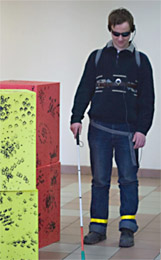 „Design and construction of a prototype personal navigation system for aiding the blind in independent travel in urban environments by integrating stereovision, auditory displays, GPS and digital terrain map technologies”
„Design and construction of a prototype personal navigation system for aiding the blind in independent travel in urban environments by integrating stereovision, auditory displays, GPS and digital terrain map technologies” Principal investigator: professor Andrzej Materka
The European Union report indicates that for every 1000 Europeans citizens 4 are blind or suffer from serious visual impairment. It is estimated that this disability among the elderly will triple with each decade of their lives. The are approx. 80 thousand visually impaired individuals living in Poland.
Visual disability is a serious barrier depriving the blind of normal active professional and social life. Only the richest countries can finance nationwide programs effectively reducing these barriers (in Sweden only 5.5% of the blind are unemployed whereas in Poland unemployment rate among the blind reaches 87%).
Abstract:The aim of the project is to develop a mobile prototype navigational system for the blind. The system is comprised of the following interconnected modules:
- electronic travel aid (ETA) for obstacle avoidance and environment perception (device model currently worked on in the Institute of Electronics),
- satellite global navigation system (GPS or Galileo),
- digital maps of urban terrain (available from the City of Lodz Land Information System).
An innovative concept of the envisioned system is the fusion of data obtained from: inertia sensors, stereoscopic images, electronic compass, and satellite navigation system for a sustained identification of local and global geographic position of a blind user in the urban environment.
The main project tasks are:
- Development of a prototype of an electronic travel aid (ETA) system for the blind. The system utilizes stereoscopic cameras and a set of inertia sensors for 3D scene reconstruction and path planning.
- Development of software packages for integration of data generated by the ETA system and the global navigation system. Algorithms for determination of the geographic position and estimation of the ego-motion parameters on the basis of video, GPS and inertial sensors data will be developed.
- Development of software procedures for mobile devices (Symbian OS smartphone). The mobile device will play the role of the auditory interface with the blind user. The visual-based menu interface will be replaced by an auditory interface based on text-to-speech synthesis.
Deployment of the personal ETA&navigation system will offer a new quality aid for safe and independent mobility of the blind. The device will support the user in such travel tasks as: obstacle avoidance, path planning, direction determination, navigation enhanced by data from the digital city map (e.g. bus stops, street addresses, bank teller machines, and pedestrian crossings)
Contact:
Professor Paweł Strumiłło, Head of Medical Electronics Division, pawel.strumillo[at]p.lodz.pl
©Institute of Electronics, Technical University of Lodz